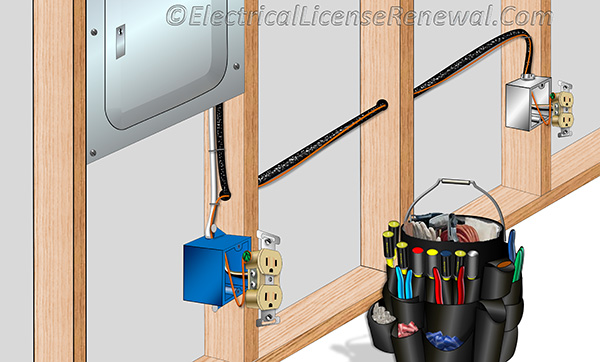250.130(C) Nongrounding Receptacle Replacement or Branch Circuit Extensions.

Code Change Summary: A new grounding method was added which specifies where an equipment grounding conductor can terminate. This new rule applies when replacing old two-wire receptacles or extending an existing branch circuit to add a new outlet or device.
Often, wiring methods in older homes consists of two-wire cables without an equipment grounding conductor. This wiring method was considered code compliant at the time of original installation and can remain as is.
Current code requires an equipment grounding conductor to be present in any new wiring method added to the older home. This can often present a problem when simply trying to extend an existing circuit to add a new receptacle or if replacing the old two-wire receptacles with the newer, grounding type, 3-prong receptacles.
If replacing old two-wire receptacles with newer, grounding type, 3-prong receptacles, rather than installing a new home run circuit all the way back to the electric panel, it may be more convenient to replace the receptacle and connect an equipment grounding conductor from the green screw on the new receptacle to any of the items listed in section 250.130(C).
If extending an existing branch circuit, instead of installing a new home run circuit all the way back to the electric panel, it may be more convenient to simply tie into an existing branch circuit nearby. If the existing nearby branch circuit does not have an equipment grounding conductor, then the equipment grounding conductor in the new wiring method can connect to any of the items listed in section 250.130(C).
Below is a preview of the NEC®. See the actual NEC® text at NFPA.ORG for the complete code section. Once there, click on the “free access” tab and select the applicable year of NFPA 70 (National Electrical code).
2011 Code Language:
250.130(C) Nongrounding Receptacle Replacement or Branch Circuit Extensions. The equipment grounding conductor of a grounding-type receptacle or a branch-circuit extension shall be permitted to be connected to any of the following:
(1) Any accessible point on the grounding electrode system as described in 250.50
(2) Any accessible point on the grounding electrode conductor
(3) The equipment grounding terminal bar within the enclosure where the branch circuit for the receptacle or branch circuit originates
(4) For grounded systems, the grounded service conductor within the service equipment enclosure
(5) For ungrounded systems, the grounding terminal bar within the service equipment enclosure.
2014 Code Language:
250.130(C) Nongrounding Receptacle Replacement or Branch Circuit Extensions. The equipment grounding conductor of a grounding-type receptacle or a branch-circuit extension shall be permitted to be connected to any of the following:
(1) Any accessible point on the grounding electrode system as described in 250.50
(2) Any accessible point on the grounding electrode conductor
(3) The equipment grounding terminal bar within the enclosure where the branch circuit for the receptacle or branch circuit originates
(4) An equipment grounding conductor that is part of another branch circuit that originates from the enclosure where the branch circuit for the receptacle or branch circuit originates
(5) For grounded systems, the grounded service conductor within the service equipment enclosure
(6) For ungrounded systems, the grounding terminal bar within the service equipment enclosure.